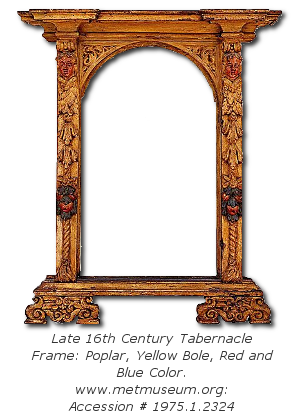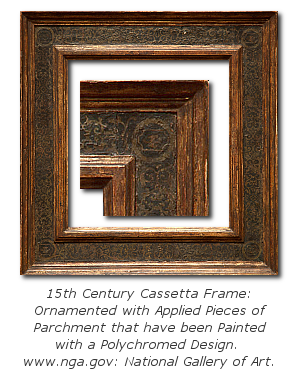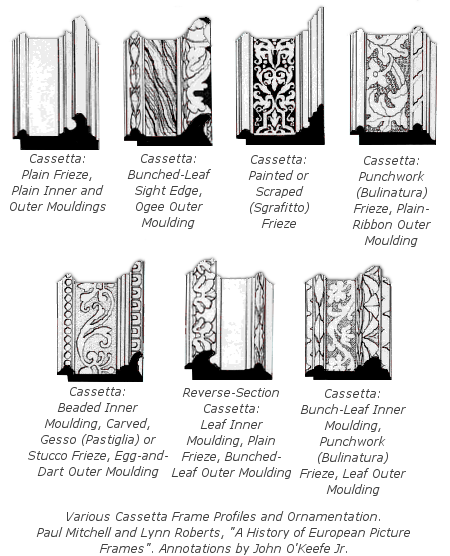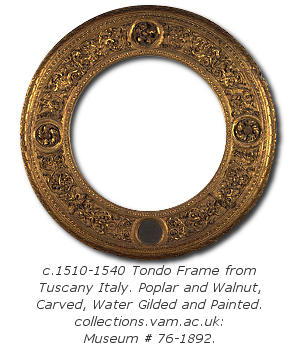"A Brief History of Frames - Renaissance"
Author: John O'Keefe Jr.(© Copyright 2012, John O'Keefe Jr.) Publisher: Painting Frames Plus
(Published Date: 2012)
(Modified Date: 2016)
Renaissance: Period: c.1400-1600
The Renaissance was a cultural and intellectual movement that spanned the period roughly from the late 14th to the early 17th centuries (c.1400-1600). The Renaissance has been broken down into three distinct phases: Early Renaissance (c.1400-1495), High Renaissance (c.1495-1527) and Late Renaissance (c.1527-1600). The ideas of the Renaissance can be traced back to the 13th century (and possibly earlier), during the period referred to as the Proto-Renaissance (e.g. Pre-Renaissance);
It is traditionally accepted that the Renaissance first emerged in Florence, Italy (marking the start of the Early Renaissance phase), and then spread slowly to the rest of Europe by the 16th century. The movement peaked during the High Renaissance, after which it started to decline during the Late Renaissance, by which time it was also competing with the Mannerist artistic movement (c.1520-1580 in Italy, c.1520-1610 in Northern Europe). The Renaissance and Mannerist movements eventually gave way to the influence of the Baroque period that emerged in the early part of the 17th century (c.1600).
Tabernacle Frame:
The earliest Italian panel paintings were carved with their frames from a single piece of wood. Larger church alterpieces could not be carved from a single piece of wood, but required several pieces glued together, and then the framing elements were glued and nailed into place. This basic structural form was used in the countless variations of Tabernacle frames, sometimes called aedicular frames, that were created during the 14th through 16th centuries. Tabernacle frames are essentially condensed alterpieces, and are often encountered with smaller religious works of art, or private devotional images.

Altarpieces in churches and cathedrals were often in triptych form, consisting of three painted or carved Tabernacle panels that are hinged together. Diptych forms consisted of two painted or carved Tabernacle panels hinged together.
(...View More Tabernacle Frames)Cassetta Frame:
A notable frame style that developed during the Early Renaissance is the Italian Cassetta frame: A simple box-like frame (Cassetta meaning "little box"), finished with gold, paint or left in the wood. These frames have on all sides the same distinctive inner and out mouldings around a rather flat central frieze.

Cassetta frames evolved from the inner mouldings of earlier tabernacle frames, which in turn evolved from the stepped-profiles of the classical architectural entablature and/or architrave. (Comparison Diagram) "The essence of these frames is the combination of linear outline and refined ornament, which enhance the paintings of the period." [1]
The central frieze might be left plain or adorned with foliate or geometric patterns. The patterns may be applied gesso (pastiglia), punch-work (bulinatura), stucco, painted, scraped - etching through a layer of paint to reveal gold that has been laid beneath (sgraffito) or, according to the wealth and intention of the purchaser, carved.

It was during the Renaissance that a more "secular" or "worldly" style of painting began to emerge, and painting compositions began shifting away from purely religious themes to include non-religious themes and subject matter. Tabernacle frames continued to be favored for art that had clear liturgical references and Cassetta style frames became the preferred choice for non-liturgical art. Noteworthy in the history of frames, the Cassetta frame was the prototype of the basic picture frame that we know today.
(...View More Cassetta Frames)Tondo Frame:
The Tondo frame has its origins in Tuscan, Italy and is a round frame; in an elliptical shape, it's called the Tondo Ovolo. The earliest known examples date back to the Proto-Renaissance period. "These were often painted roundels used on altarpieces with raised or punched edges, indicating a border. During the 14th century astragals were added to the inner and outer edges of the border, creating a cassetta-like surround. (Astragals are narrow, convex mouldings, often with a form of beading on them.)" [2]

During the Early Renaissance, the design developed into a standalone, sculptured object with ornaments including lush fruit and floral forms emanating from gilt wood and glazed terracotta tondi.
Sansovino Frames:
References:
- Paul Mitchell and Lynn Roberts, "A History of European Picture Frames"
- Mark Guthrie, "Style Snapshot: A look at a frame, its characteristics, and history", (September 2004)
Bibliography:
- Paul Mitchell and Lynn Roberts, "A History of European Picture Frames"
- Paul Mitchell and Lynn Roberts, "Frameworks: Form, Function & Ornament in European Portrait Frames", ISBN: 1-85894-037-0
- www.wikipedia.com, "Renaissance; High Renaissance", (Retrieved 08/09/12)
- www.metmuseum.org, "Heilbrunn Timeline of Art History: Italian Renaissance Frames - The Tabernacle Frame", (Retrieved 08/09/12)
- www.metmuseum.org, "Heilbrunn Timeline of Art History: Italian Renaissance Frames - The Cassetta Frame", (Retrieved 08/09/12)
- en.wiktionary.org, "Cassetta" (Retrieved 08/09/12)
- National Gallery of Art, "A Bounty of Frames: From Period Frames to No Frame"
- Diane Day, "A Survey of Frame History: Part II, Moveable Frames", (September 1998)
- Greta Chaplin-McGill, "Renaissance Picture Framing Techniques", (Retrieved 08/09/12)
- Robert Wilde, "Introduction to the Renaissance", (Retrieved 08/09/12)
- Mark Guthrie, "Style Snapshot: A look at a frame, its characteristics, and history", (September 2004)